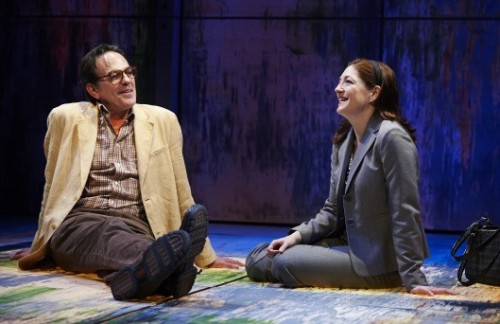Hope and Gravity at City Theatre
A Freefalling Drama in Pittsburgh.
By: Wendy Arons - May 14, 2014
There’s a distinctive pleasure that derives from stories told out of sequence. Pleasure has something to do with the fact that a non-linear structure allows the writer to indulge in coincidence, which is usually considered “bad” plotting in a narrative that moves forward sequentially from the beginning: the intersection of two characters’ trajectories in a forward moving narrative often feels contrived, but when the narrative begins at the end (or, in the case of Michael Hollinger’s thoughtful and charming new play Hope and Gravity, in the middle), the ways in which a single event connects a group of strangers feel necessary, as the ending depends on the events that lead to it. So, as readers or viewers, we get to delight in the jigsaw puzzle of coincidence without feeling like the writer is simply manipulating fate to bring the story to a resolution.
But I get ahead of myself (or maybe behind myself – I feel like I started this post in the middle, too!). Hope and Gravity (currently at City Theater, in an excellent production directed by Tracy Brigden), interweaves the stories of nine characters whose lives intersect with an inexplicable and tragic elevator accident. The play begins on the morning after the accident, as two graduate students of poetry, Jill (Robin Abramson) and Steve (Federico Rodriguez) are delayed in getting to class by an elevator undergoing a safety inspection. They are stuck in the elevator with Marty (John Feltch), the elevator repairman, and Peter (Daniel Krell), whom Marty recognizes as his dentist, and who has a vexed relationship with the truth.
This meeting of strangers, stopping on random floors as they are impatient to be elsewhere, serves as a metaphor for the play itself, which moves randomly back and forth through time and among characters whose lives collide as they are busy doing other things (if you study the program closely, which I didn’t until I sat down to write this post, you’ll see that the play begins with Scene 6, then jumps to 2, then 4, and so on, ending with the accident that is pivotal to the play).
The connections between the characters sometimes feel a teeny bit pat (for example, Marty’s wife, Nan (Rebecca Harris), is a nurse in the same school where Steve’s fiancé, Barb, is a secretary to Hal, the Vice Principal, whose wife, Tanya, dies in the elevator accident), a feeling reinforced by the fact that most of the actors play two roles (Abramson plays Barb, Krell plays Hal, Harris is also Tanya, and Feltch is Douglas, Jill and Steve’s professor of poetry). But these interconnections avoid feeling contrived, mainly because we’ve already experienced fate’s hand dealt in the first scene, so that the subsequent presentation of the backstory comes across as causal – that is, those connections are the dominoes that needed to have fallen in order for the play to begin on floor six in the first place, so to speak.
Moreover, Hope and Gravity seems, in this respect, a play particularly suited for a town like Pittsburgh, where it seems unusually likely to run into your hairstylist at the ballet, or to find yourself sitting one row back from your kid’s soccer coach at the Pirates’ game, or to hear that your colleague has just rented your best friend’s mother’s house. In such a context, it doesn’t feel farfetched at all when, in the penultimate scene of the play, Steve realizes that the man he is buying a house from is the elevator repairman he met years earlier and marvels at what a small world it is, indeed.
The smallness of the world is only one interest of this play, however. It also dwells, with much wit and comic insight, on the dreams and aspirations of its nine characters, and on the ways their hopes keep them busy and aloft while gravity does its work on them and others. This is a play that will tickle your funnybone as you watch it and give you plenty to chew on philosophically over drinks after. The cast is terrific, and the production design (sets Anne Mundell, costumes Robert C. T. Steele, lighting Andrew David Ostrowski, music Eric Shimelonis, and sound Joe Pino) deserves special mention, as it whisks us seamlessly and almost magically from scene to scene, actors and space transforming almost instantaneously as the pieces of the story’s puzzle come together.
Reposted courtesy of Wendy Arons and The Pittsburgh Tatler.


